Have you ever wondered how an off-the-shelf elearning course goes from an idea to a fully-formed online module, and who’s responsible for that process? We sat down with one of Nimble’s very own Learning Designers, Shaena, to ask her all about it – and found out there’s a lot more to releasing a Nimble Essentials course than you might expect! Watch Shaena’s video below…
The Seven Steps to Create a Nimble Essentials Course
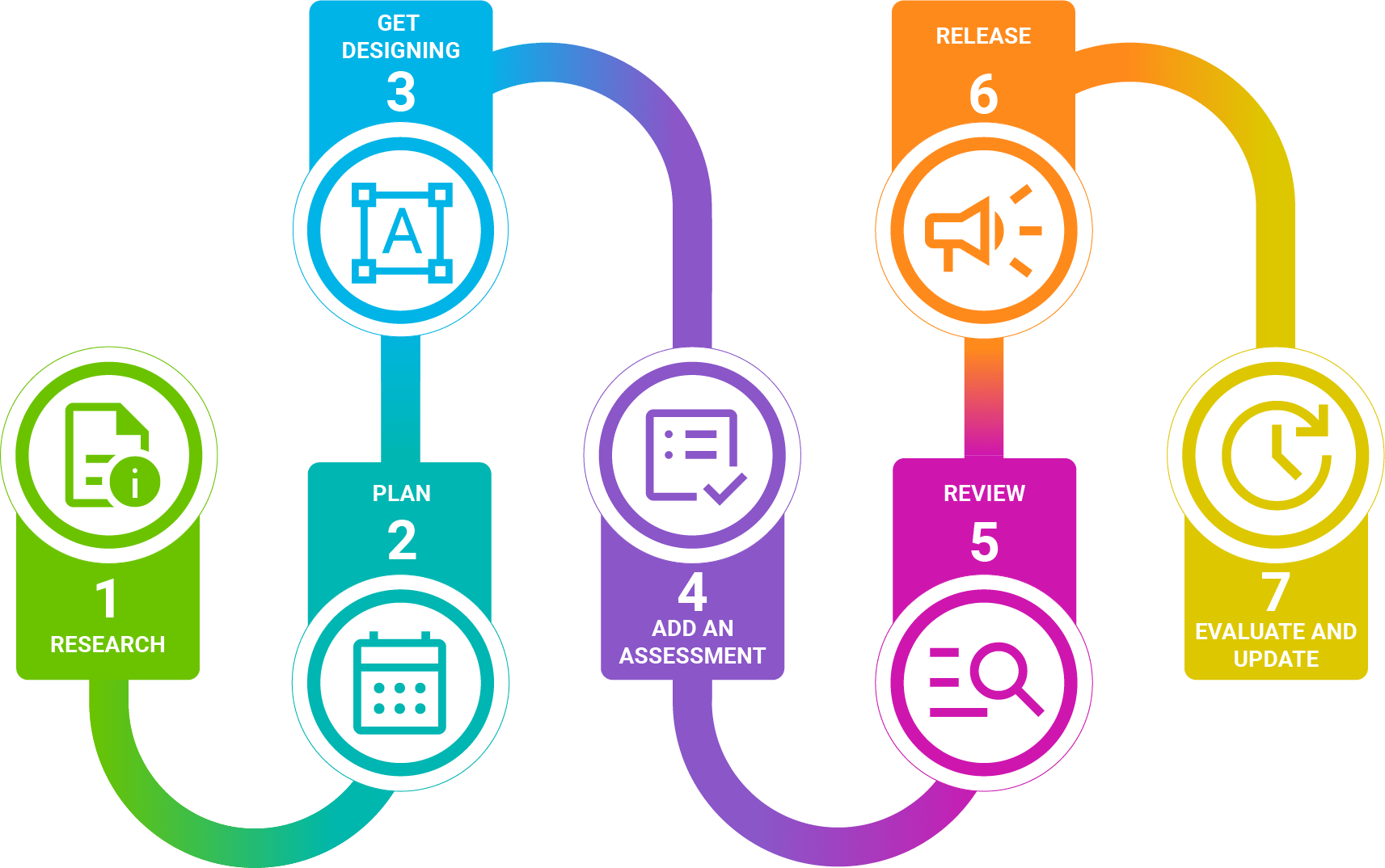

Step 1: Research
Once we’ve identified a need for an elearning course on a particular subject for our customers, Nimble’s Learning Designers start with some basic, broad research: looking at government sources and key legislation to get a solid understanding of the topic. Once confident they’ve pinned down the major issues, the team will often consult Subject Matter Experts (SMEs) in the field. For example, when writing our Sexual Harassment Awareness Essentials course, they brought in an HR Consultant to check their understanding of the law and how it should be applied in the workplace.
This can be quite a challenging stage, as Shaena attests:
“It’s really hard because you have an overwhelming amount of information and you need to narrow that down. It’s remembering the audience all the time: what exactly do they need to do as a result of this course?”
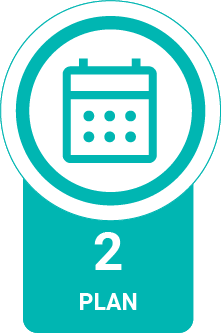
Step 2: Plan
The very first element of the planning stage is arguably the most important: deciding on the learning objectives (LOs) for the course. This is where that key point Shaena makes about the learner behaviour you’re trying to influence comes into its own: how can you write LOs that distil those behaviours down, and link to the learner’s role? For each Nimble Essentials course, we select no more than five key outcomes.
The next stage involves Shaena’s favourite metaphor when it comes to designing elearning: the backbone!
“In terms of how we structure a course, I like to think of it as a spine. So we have the central nerve, which is our learning objectives, and then the vertebrae are our topics and pages. Each vertebra has to add something to support those objectives.”
The core themes of the course are split into topics, and a high-level design is sketched out, always keeping learning theory in mind: how can we make sure the most important information gets across, and how can we design the course to facilitate that? It’s why you’ll see a few key elements (like introduction and summary pages for each topic, frequent knowledge checks, and exercise feedback) in all our Nimble Essentials courses.
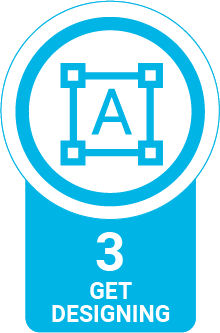
Step 3: Get designing
Then it’s straight into Nimble Author to design on the page, as Shaena says:
“We then very quickly go into the authoring tool because it’s so easy to design straight into it without a need for storyboarding elsewhere. We start making pages, and we can just chop them around later.”
Once the basic structure is there, further research is often required to get the details right, and then the team thinks about any media that will be needed to make sure the content is as engaging as possible; do we need video, animations, illustrations or audio? Our Learning Designers write detailed briefs for each piece of media required and work with creatives to get them just right.
It could be easy to write a dry, formulaic course (particularly when the subject isn’t the most naturally thrilling – UK GDPR, anyone?). But our Learning Designers know that it’s not just about the objectives and the knowledge: it’s also about building a rapport with learners. A difficult task when you have no idea who they are, and are communicating through a series of course pages!
“Where we start is to think: if this was delivered face-to-face by a good trainer, what would they be doing? And how do we account for the loss of that face-to-face element in the elearning? Rapport is key and also quite difficult, so you have to think about the language you’re using and appeal to the learner directly. You’re telling a story; you’re becoming a storyteller – and injecting it with a bit of humour and light-heartedness as well, where appropriate.”
What we call the ‘learning flow’ is also critical. This comes back to why we use introductions and summaries for each topic: there’s a large body of research that clearly shows how important repetition is to learning and memory. Calling back to a key point from earlier in the course – but without being heavy-handed – helps that information sink in. We also use carefully-written case studies, encouraging the learner to put themselves in the shoes of a person facing a problem at work and using what they’ve learned so far to solve that problem.
And, of course, our Learning Designers are constantly checking back to make sure that every page supports that central spine; each interactive activity, paragraph or animation brings us a little bit closer to those learning objectives.
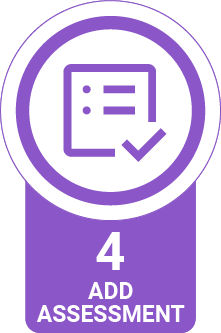
Step 4: Add an assessment
This bit’s easy, right? Not so much…
“The assessments are sneaky because you think: oh, I’ve done the course now, all I need to do is write ten questions! But actually, to get a good assessment you need to go back and make sure the questions are reflective of the action or behaviour that this person needs to take away. It’s very easy to write an assessment that doesn’t bear any relation to the learning objectives!”
It’s also important to make sure that your multiple-choice assessment doesn’t resemble an endurance exercise, or contain pointless facts that are buried in a link somewhere way back in the course. The point of the test (and indeed the whole elearning course) is to make sure that, when it comes to the crunch, the learner can recall the best course of action. And (unless you’re crafting a module for solicitors) it’s unlikely that knowing the Health and Safety at Work Act came into force in 1974 is going to help them do so!
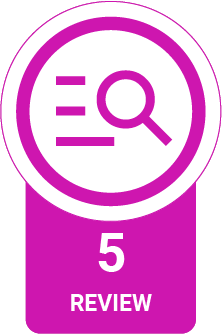
Step 5: Review
We take the quality of our elearning courses very seriously here at Nimble. Each course goes through multiple rounds of review, starting with any external SMEs, to check for factual accuracy. Then the course is combed through by the whole Learning Design team, to make sure the all-important learning flow works well – and finally, it’s passed around the wider Nimble team. Having more pairs of eyes on the finished product can only be a good thing; not just for typo-spotting purposes (although the Marketing team are pretty eagle-eyed, if we do say so ourselves) but to check any potential misunderstandings, poorly-worded questions or differing points of view.
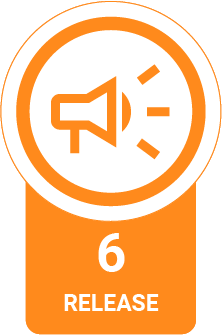
Step 6: Release
Once any final edits have been made, it’s time to release a brand-new Nimble Essentials course into the wild! This is always a slightly nerve-wracking moment for Shaena:
“I think the overwhelming sense is one of responsibility, because it is amazing thinking that these courses are going out and they’re changing behaviours hopefully for the better. You do feel that these courses are your little babies! It’s very rewarding, but you do feel very responsible.”
Then it’s over to the Marketing team to promote it, and our Customer Success Managers to share the news with our clients.
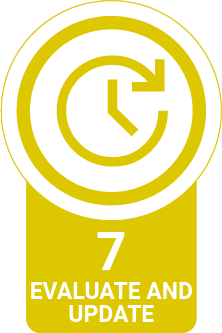
Step 7: Evaluate and Update
It’s not over yet! After a Nimble Essentials course is released, we don’t just forget about it; we pride ourselves on making sure our elearning is of the highest quality, and keeping it up-to-date is an important part of that. Our Learning Designers keep a weather eye on any upcoming legislative changes or trends to ensure our customers can always rely on the information in our courses being accurate and trustworthy. And regardless of changes to the law, every Nimble Essentials course receives an annual update and refresh. Of course, we also check in with customers and learners to make sure our courses are having an impact. Are those learning objectives being met, and are they making a difference to employers? This valuable feedback also helps us refine our approach, keeping course content relevant and effective.

So there you have it: a Nimble Essentials course from start to finish (and beyond). A huge thank you to Shaena for letting us peek behind the curtain and get a sense of just how much work goes into each elearning course we release – and for embodying our strapline: “trusted learning, professionally crafted”.

ABOUT THE AUTHOR
Hannah is Nimble’s Learning Adviser, providing L&D insights that our current and prospective customers value. Writing thought provoking articles that are delivered across multiple formats as well as a range of initiatives including training, white papers, videos, elearning courses, blogs, seminars, webinars, monthly emails, knowledge bases, case studies, podcasts and one-to-one meetings.


0 Comments